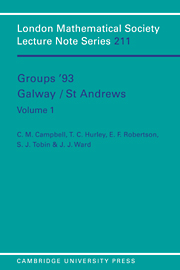Book contents
- Frontmatter
- Contents
- Preface
- Introduction
- Geometry, Steinberg representations and complexity
- The structure of metabelian finite groups
- Table algebras of extended Gagola-type and applications to finite group theory
- On the saturation of formations of finite groups
- Locally constructed formations of finite groups
- Reflections on virtually one-relator groups
- Rickard equivalences and block theory
- Computing the conjugacy classes of elements of a finite group
- Quotient categories of modules over group algebras
- Weak chain conditions for non-almost normal subgroups
- Computation of the character table of affine groups using Fischer matrices
- The lattice of compact representations of an infinite group
- Automorphisms of nilpotent and related groups
- Generation of orthogonal groups over finite fields
- The structure of certain Coxeter groups
- n-free groups and questions about universally free groups
- Classification of all generating pairs of two generator Fuchsian groups
- Parametric words and models of the elementary theory of non-abelian free groups
- The groups G(n, l) as fundamental groups of Seifert fibered homology spheres
- Lifting automorphisms: a survey
- (MI)-groups acting uniserially on a normal subgroup
- Revisiting a theorem of Higman
- Cohomological finiteness conditions
Lifting automorphisms: a survey
Published online by Cambridge University Press: 02 March 2010
- Frontmatter
- Contents
- Preface
- Introduction
- Geometry, Steinberg representations and complexity
- The structure of metabelian finite groups
- Table algebras of extended Gagola-type and applications to finite group theory
- On the saturation of formations of finite groups
- Locally constructed formations of finite groups
- Reflections on virtually one-relator groups
- Rickard equivalences and block theory
- Computing the conjugacy classes of elements of a finite group
- Quotient categories of modules over group algebras
- Weak chain conditions for non-almost normal subgroups
- Computation of the character table of affine groups using Fischer matrices
- The lattice of compact representations of an infinite group
- Automorphisms of nilpotent and related groups
- Generation of orthogonal groups over finite fields
- The structure of certain Coxeter groups
- n-free groups and questions about universally free groups
- Classification of all generating pairs of two generator Fuchsian groups
- Parametric words and models of the elementary theory of non-abelian free groups
- The groups G(n, l) as fundamental groups of Seifert fibered homology spheres
- Lifting automorphisms: a survey
- (MI)-groups acting uniserially on a normal subgroup
- Revisiting a theorem of Higman
- Cohomological finiteness conditions
Summary
Introduction
Let F = Fn be the free group of a finite rank n ≥ 2 with a fixed set {xi;, 1 ≤ i ≤ n} of free generators. If R is a characteristic subgroup of the group F then the natural homomorphism ∈R : F → F/R induces the mapping τR : AutF → Aut(F/R) of the corresponding automorphism groups. Those automorphisms of the group F/R that belong to the image of τR are usually called tame. In this survey, we will be concerned with the following general question: How to determine whether or not a given automorphism of a group F/R is tame? In a more general situation, when R is an arbitrary normal subgroup of F, one can ask if a given generating system of the group F/R can be lifted to a generating system of F (in this case the system will be also called tame). This question has important applications to low-dimensional topology (see, for instance, [LuMol]).
The questions of lifting automorphisms and generating systems naturally give rise to the following two problems of independent interest:
(1) Finding appropriate necessary and/or sufficient condition(s) for an endomorphism of the group Fn to be an automorphism;
(2) Describing (in one or another way) the group Ant(F/R) or generating systems of a group F/R.
- Type
- Chapter
- Information
- Groups '93 Galway/St Andrews , pp. 249 - 263Publisher: Cambridge University PressPrint publication year: 1995
- 1
- Cited by



